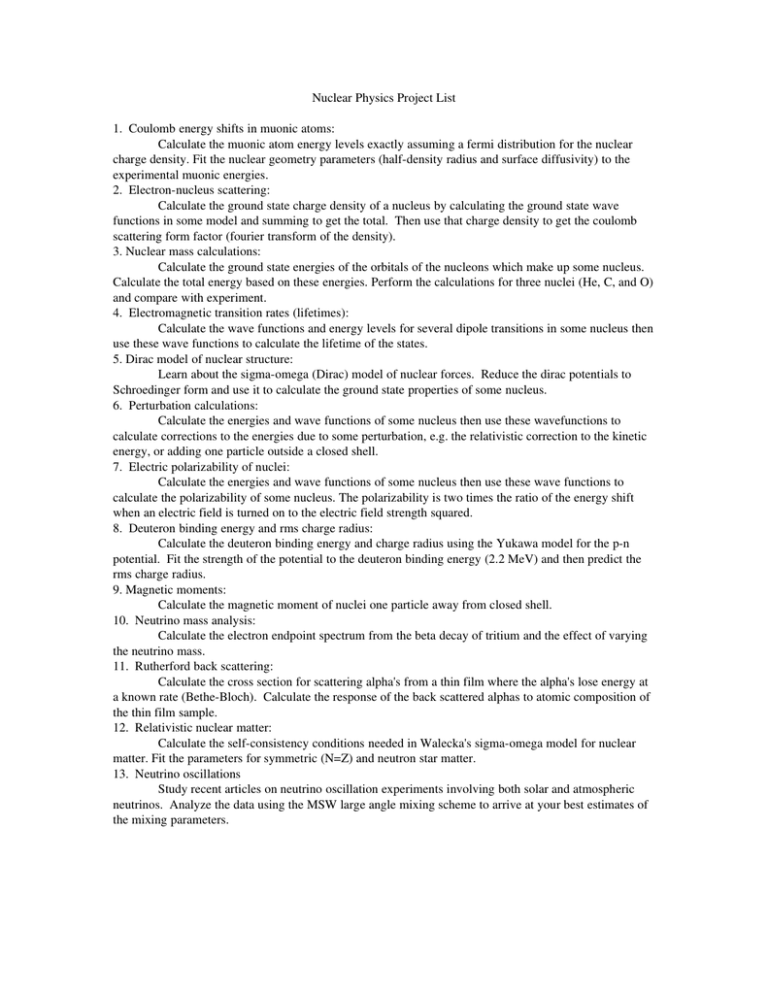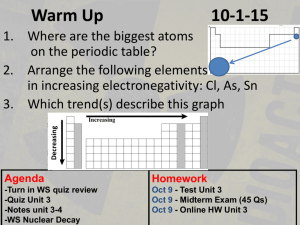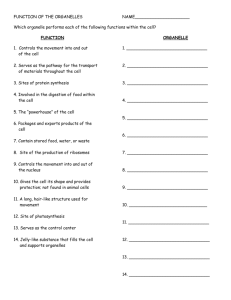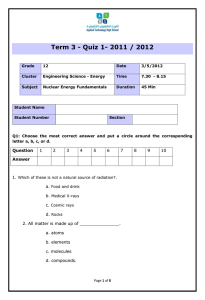Nuclear Physics Project List 1. Coulomb energy shifts in muonic atoms: Calculate the muonic atom energy levels exactly assuming a fermi distribution for the nuclear
advertisement

Nuclear Physics Project List 1. Coulomb energy shifts in muonic atoms: Calculate the muonic atom energy levels exactly assuming a fermi distribution for the nuclear charge density. Fit the nuclear geometry parameters (half­density radius and surface diffusivity) to the experimental muonic energies. 2. Electron­nucleus scattering: Calculate the ground state charge density of a nucleus by calculating the ground state wave functions in some model and summing to get the total. Then use that charge density to get the coulomb scattering form factor (fourier transform of the density). 3. Nuclear mass calculations: Calculate the ground state energies of the orbitals of the nucleons which make up some nucleus. Calculate the total energy based on these energies. Perform the calculations for three nuclei (He, C, and O) and compare with experiment. 4. Electromagnetic transition rates (lifetimes): Calculate the wave functions and energy levels for several dipole transitions in some nucleus then use these wave functions to calculate the lifetime of the states. 5. Dirac model of nuclear structure: Learn about the sigma­omega (Dirac) model of nuclear forces. Reduce the dirac potentials to Schroedinger form and use it to calculate the ground state properties of some nucleus. 6. Perturbation calculations: Calculate the energies and wave functions of some nucleus then use these wavefunctions to calculate corrections to the energies due to some perturbation, e.g. the relativistic correction to the kinetic energy, or adding one particle outside a closed shell. 7. Electric polarizability of nuclei: Calculate the energies and wave functions of some nucleus then use these wave functions to calculate the polarizability of some nucleus. The polarizability is two times the ratio of the energy shift when an electric field is turned on to the electric field strength squared. 8. Deuteron binding energy and rms charge radius: Calculate the deuteron binding energy and charge radius using the Yukawa model for the p­n potential. Fit the strength of the potential to the deuteron binding energy (2.2 MeV) and then predict the rms charge radius. 9. Magnetic moments: Calculate the magnetic moment of nuclei one particle away from closed shell. 10. Neutrino mass analysis: Calculate the electron endpoint spectrum from the beta decay of tritium and the effect of varying the neutrino mass. 11. Rutherford back scattering: Calculate the cross section for scattering alpha's from a thin film where the alpha's lose energy at a known rate (Bethe­Bloch). Calculate the response of the back scattered alphas to atomic composition of the thin film sample. 12. Relativistic nuclear matter: Calculate the self­consistency conditions needed in Walecka's sigma­omega model for nuclear matter. Fit the parameters for symmetric (N=Z) and neutron star matter. 13. Neutrino oscillations Study recent articles on neutrino oscillation experiments involving both solar and atmospheric neutrinos. Analyze the data using the MSW large angle mixing scheme to arrive at your best estimates of the mixing parameters.







